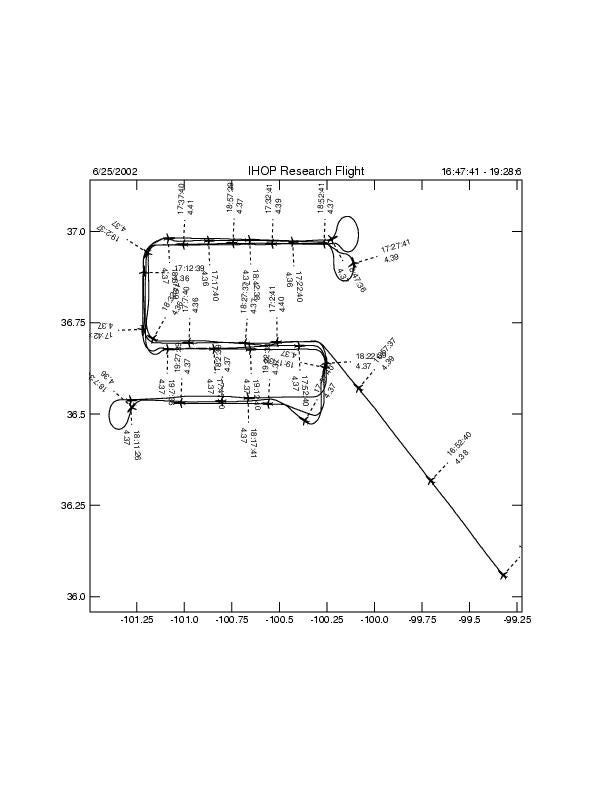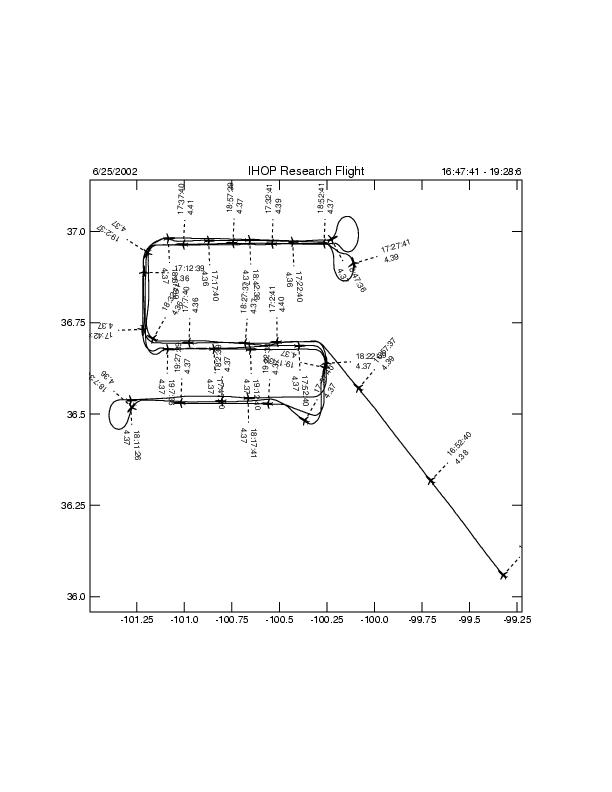P3 Flight Log:
After a 24 hour delay, the last mission of IHOP was scheduled to take place on the last day of operations. It was to be a boundary layer evolution mission involving two aircrafts. The King Air was scheduled for an 1100 UTC take off and the P3 was to depart an hour later. The flight pattern of the mission was changed from the previous BLE mission with the P3 flying at 14500? MSL instead of 3200? MSL. The King Air was to remain at low altitude, but they would be directly beneath the P3. Also, LEANDRE would be pointing downward instead of sideward. At the request of the pilots on both planes, a flight coordination meeting was held the night before. On the two previous missions the two planes were flying nearly in tandem, but on this mission we would be flying in opposite direction of each other and required to pass over and under each other roughly in the middle of the east-west legs. The pilots were given the waypoints and they calculated the distances for all of the legs and worked out all of the coordination. As always this was greatly appreciated and it was comforting knowing that we would not need to deal with this at 4:30 am CDT. As a result the pre-flight briefing at the airport was brief and we all got ready to depart. Unfortunately, the P3 encountered mechanical problems and we were not able to leave on time. Engine 4 would not start and it was determined that the starter was bad. It was replaced, but as it would turn out, the replacement part was not aligned properly and the delay became fairly extensive. The mechanics contacted Patuxent River Naval Air base and received instructions about how to realign the starter and they fixed it. On top of having a starter problem, we also had an oil leak in the same engine. It was also repaired and found to be barely within the allowed limits for flying. Special thanks to the mechanics, they worked very hard to get us of the ground as quickly as possible. After a delay of 4 1/2 hours, we finally took off at 1625 UTC and headed toward the S-POL region. We contacted S-POL and the King Air in flight and as always the pilots worked out the coordination. We started the first leg at 1700 UTC at point PC going to PD. LEANDRE estimated the boundary layer to be around 600 m deep and it grew to about 1.5 km throughout the afternoon. We were a little bit worried about ELDORA, as we had not collected great data on the two previous missions, but this was not the case on this flight. We believe that we were observing a boundary layer structure with convective rolls on the ELDORA display. The in-situ data also was truly remarkable. We saw incredible fluctuations in the mixing ratio along all of the legs in both the east-west and the north-south directions. There was some discussion as to whether or not we were observing bores or gravity waves. LEANDRE also collected good data. We stayed on station until 2030 UTC. We did encounter some equipment problems. The Exabyte tape drive for LEANDRE died, which caused a 15 minute gap in their data. Also, ELDORA?s tape drive had some problems and they were forced to restart the system. However, the loss of data was not extensive and it was the general consensus that a great dataset was collected. We returned to OKC after a couple of fly overs over S-POL and landed at 2145 UTC for the last time. We attempted to do a calibration leg on the way back, but ELDORA had some technical problems, so it is not clear if we were successful.
As a final note, I would like to extend my sincere thanks to the entire crew from the NRL P3. It has been a joy to work with all of you. Thanks for all of your hard work and your constant desire to make sure that the missions were carried out as perfect as possible.
Flight Track:
ELDORA Images for this Flight:
(Hit submit to view images, and allow pop-up windows to view interactive flight track.)
Data Policy
Data Set Documentation Guidelines
Data Submission Instructions
ARM IHOP Page
CAPS IHOP Research Group
GAPP Field Project
NCAR MM5
NCAR NEXRAD Scan Volume Logs
NCAR RAL IHOP Page
NOAA/SPC/NSSL Spring Program 2002
PSU ABL Group IHOP Page
SSEC/CIMS IHOP Page
SSEC/S-HIS IHOP Page
ELectra DOppler RAdar (ELDORA)
Integrated Surface Flux System (ISFS)

